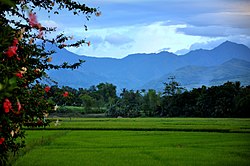Isabela, Negros Occidental
Isabela | |
|---|---|
| Municipality of Isabela | |
 Barangay Camangcamang with Mabinay Mountains in the distance | |
| Nickname: The Sweet Heart of Negros | |
 Map of Negros Occidental with Isabela highlighted | |
Location within the Philippines | |
| Coordinates: 10°12′N 122°59′E / 10.2°N 122.98°E | |
| Country | |
| Region | Western Visayas |
| Province | Negros Occidental |
| District | 5th district of Negros Occidental |
| Barangays | 30 (see Barangays) |
| Government | |
| • Type | Sangguniang Bayan |
| • Mayor | Irene C. Montilla |
| • Vice Mayor | Renato M. Malabor Jr. |
| • Congresswoman | Ma. Lourdes T. Arroyo |
| • Electorate | 41,301 voters (2022) |
| Area | |
| • Total | 178.76 km2 (69.02 sq mi) |
| Population (2020 census)[3] | |
| • Total | 64,516 |
| • Density | 360/km2 (930/sq mi) |
| Economy | |
| • Income class | 2nd municipal income class |
| • Poverty incidence | 26.84% (2015)[4] |
| • Revenue (₱) | ₱ 200.6 million (2020) |
| • Assets (₱) | ₱ 375.4 million (2020) |
| • Liabilities (₱) | ₱ 72.84 million (2020) |
| • Expenditure (₱) | ₱ 235.5 million (2020) |
| Time zone | UTC+8 (PST) |
| ZIP code | 6128 |
| PSGC | |
| IDD : area code | +63 (0)34 |
| Native languages | Hiligaynon Ati Tagalog |
| Website | www |
Isabela, officially the Municipality of Isabela, is a 2nd class municipality in the province of Negros Occidental, Philippines. According to the 2020 census, it has a population of 64,516 people.[3]
Isabela is known for BISCOM (Binalbagan Isabela Sugar Company).
In 1951, the barrios of Magallon, Odiong and Guinpanaan were separated from Isabela and formed into the town of Magallon (now Moises Padilla).[5]
Barangays
Isabela is politically subdivided into 30 barangays ("Pob." means poblacion).
- Amin
- Banogbanog
- Bulad
- Bungahin
- Cabcab
- Camangcamang
- Camp Clark
- Cansalongon
- Guintubhan
- Libas
- Limalima
- Makilignit
- Mansablay
- Maytubig
- Panaquiao
- Barangay 1 (Poblacion)
- Barangay 2 (Poblacion)
- Barangay 3 (Poblacion)
- Barangay 4 (Poblacion)
- Barangay 5 (Poblacion)
- Barangay 6 (Poblacion)
- Barangay 7 (Poblacion)
- Barangay 8 (Poblacion)
- Barangay 9 (Poblacion)
- Riverside
- Rumirang
- San Agustin
- Sebucawan
- Sikatuna
- Tinongan
Demographics
| Year | Pop. | ±% p.a. |
|---|---|---|
| 1903 | 12,836 | — |
| 1918 | 19,653 | +2.88% |
| 1939 | 43,509 | +3.86% |
| 1948 | 33,743 | −2.78% |
| 1960 | 29,769 | −1.04% |
| 1970 | 33,636 | +1.23% |
| 1975 | 37,400 | +2.15% |
| 1980 | 39,704 | +1.20% |
| 1990 | 47,010 | +1.70% |
| 1995 | 49,019 | +0.79% |
| 2000 | 48,719 | −0.13% |
| 2007 | 58,819 | +2.63% |
| 2010 | 59,523 | +0.43% |
| 2015 | 62,146 | +0.82% |
| Source: Philippine Statistics Authority[6][7][8][9] | ||
Festival
"Tigkalalag" is celebrated on the evening of Nov. 2 every year in the town of Isabela.[10] The Pana-ad victory of Tigkalalag festival is expected to boost the attraction of this unique festival that began in Purok Manacup beside the public cemetery in Isabela town where people would have fun during the night of All Souls Day that was capped with a beauty pageant called Search for the White Lady. It spun off into the municipal festival under Mayor Renato Malabor, when the town was searching for a festival that was going to be its tourism plank.
Tigkalalag festival of Isabela turned what otherwise are morbid concepts of coffins, candelabras and crashing tombs into a whimsical, tightly-designed, skillfully-choreographed presentation that sent it howling to success in yearly competition of all the festivals of Negros Occidental. Tigkalalag is Hiligaynon for All Souls' Day.
References
- ^ Municipality of Isabela | (DILG)
- ^ "Province:". PSGC Interactive. Quezon City, Philippines: Philippine Statistics Authority. Retrieved 12 November 2016.
- ^ a b Census of Population (2020). "Region VI (Western Visayas)". Total Population by Province, City, Municipality and Barangay. Philippine Statistics Authority. Retrieved 8 July 2021.
- ^ "PSA releases the 2015 Municipal and City Level Poverty Estimates". Quezon City, Philippines. Retrieved 12 October 2019.
- ^ "An act creating the municipality of Magallon in the province of Negros Occidental". LawPH.com. Retrieved 2011-04-09.
- ^ Census of Population (2015). "Region VI (Western Visayas)". Total Population by Province, City, Municipality and Barangay. Philippine Statistics Authority. Retrieved 20 June 2016.
- ^ Census of Population and Housing (2010). "Region VI (Western Visayas)" (PDF). Total Population by Province, City, Municipality and Barangay. National Statistics Office. Retrieved 29 June 2016.
- ^ Censuses of Population (1903–2007). "Region VI (Western Visayas)". Table 1. Population Enumerated in Various Censuses by Province/Highly Urbanized City: 1903 to 2007. National Statistics Office.
{{cite encyclopedia}}: CS1 maint: numeric names: authors list (link) - ^ "Province of". Municipality Population Data. Local Water Utilities Administration Research Division. Retrieved 17 December 2016.
- ^ "Municipality of Isabela". Negros Occidental Provincial Government. Retrieved 6 March 2013.

